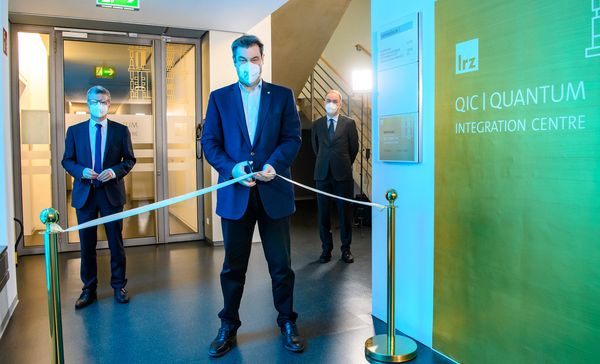NEWSFLASHES
Quantum Integration Centre Opened at LRZ
GCS Newsflash 03/2021 –

Markus Söder, Minister-President of Bavaria, cuts the ribbon to officially open the Quantum Integration Centre (QIC) at Leibniz Supercomputing Centre (LRZ) in Garching near Munich. Left: Bernd Sibler, Bavarian Minister of Science and the Art, right: LRZ Director Professor Dr. Dieter Kranzlmüller
© Bavarian State Chancellery/Bayerische Staatskanzlei
With the QIC, LRZ pursues three important goals that not only benefit the centre, but also contribute to the development of the Munich Quantum Valley:
- The installation and expansion of services for scientists engaged with quantum computing.
- The development of hardware and software to integrate quantum computing into traditional HPC workflows.
- Exchange of ideas and best practices with the international quantum computing community in order to develop a more comprehensive picture of users’ challenges and needs with regard to leveraging quantum computing resources.
LRZ partnered with Atos, installing the firm’s Atos Quantum Learning Machine (Atos QLM)—the current most powerful commercially available quantum simulator—in the centre’s compute building and adding it to its portfolio of computing resources. The Atos QLM was designed specifically for researchers to develop algorithms for quantum computing architectures as well as running initial quantum simulations without the need for additional specialized hardware.
While the first quantum algorithms and applications are already being developed, the LRZ is working on quantum processors with the Finnish-German startup IQM and other partners. "Digital-Analog Quantum Computing" (DAQC) is the name of the project funded by the German Federal Ministry of Education and Research (BMBF), which combines the technology of analog, controllable systems with that of digital-universal quantum computers whose computing power increases with each qubit. These innovative control units will initially work in conjunction with the LRZ's high-performance systems.
Since 2019, LRZ has offered researchers a quantum simulator on its current flagship supercomputer, SuperMUC-NG, which allows researchers to run models with up to 42 virtual “qubits,” or quantum bits, in order to develop and test algorithms’ performance in a quantum computing environment.
For more information, please visit http://qic.lrz.de/ or https://www.lrz.de/presse/ereignisse/2021-03-17-LRZ-eroeffnet-Quantum-Integration-Centre/